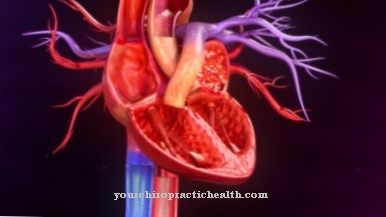The Reactive force is a form of quick strength that is based on the stretch-shortening cycle. The cycle is an active lengthening of muscles followed by contraction of the same muscles. The reactive force is abolished or restricted, for example in neuromuscular diseases.
What is the reactive force?

The nerve-muscle system overcomes various resistances with innervation processes and metabolic processes for muscle contraction. This process is called concentric work.
The nerve-muscle system is characterized by different types of strength. One of them is the reactive force. In sports medicine, this means the strength that is required for reactive movements. The reactive force characterizes reactive movements. These include, for example, the movement sequences for jumps, sprints or Wuf movements.
One process of reactive force is, for example, the stretching-shortening cycle in the muscles. This cycle corresponds to the active lengthening of muscles, followed by muscle contraction. Reactive movements always consist of a rapid succession of yielding and overcoming work that takes place against resistance. In addition to reactive strength, sports medicine knows maximum strength and rapid strength as types of strength. The reactive force is a special form of rapid strength.
Function & task
Reactive movements are a rapid succession of eccentric and concentric working methods of the muscles. In the eccentric phase, the teno-muscular system stores a certain amount of kinetic energy within its parallel and serial elastic structures. The stored energy is released in the concentric phase. This results in an increase in performance and strength.
The reactive force depends on the basis of neuro-muscular factors and the elasticity of the tendinous structures. The basis for the described increase in performance is the stretching-shortening cycle for activating the muscle spindle. An eccentric stretching of the muscles in combination with the independent elasticity and innervation behavior is followed by a concentric phase. This concentric phase works with the pre-activation and the stored tension energy as well as the reflex innervation of the previous phase.
The muscle fiber cross-section determines performance. In addition, the composition and the elasticity or innervation behavior of the muscles, ligaments and tendons determine the performance of the reactive force. The innervation and elasticity behavior is called reactive tension. The reactive force corresponds to the eccentric-concentric rapid force for the shortest coupling of both work phases. Put more simply, the reactive force is the human ability to generate an impulse in the stretch-shortening cycle.
In the stretch-shortening cycle, the weight of the body or other muscles cause an eccentric and concentric contraction of a certain muscle. The muscles are plastic and elastic at the same time. For this reason, the contraction must take place immediately after the muscle stretching and concentrate on a phase in which the muscles have not yet adjusted to the stretch.
This stretching-shortening cycle benefits from the stored energy from previous movements and therefore takes place particularly quickly. Some sources speak of energy storage in the muscles. Others see the connective tissue as a place of storage. The tendons and ligaments are stretched to the limit during the stretching-shortening cycle. For this reason, elasticity is a decisive factor for the reactive force. The elasticity varies from person to person, so that the reactive force also varies from person to person.
You can find your medication here
➔ Medicines for muscle weaknessIllnesses & ailments
Reactive strength is limited after typical sports injuries. Rehabilitation, including plyometry, is typically used to regain it. This is a high-speed strength training that promotes the stretch reflex of the tendons and muscles. In addition, the patient regains control of the muscle spindle apparatus by means of plyometry.
The training is not limited to sports injuries, but is part of the standard training for high jumpers, sprinters, basketball players or goalkeepers. In all of the sports mentioned, sprinting speed and jumping ability are crucial skills. In addition to the exercises for jumping strength, there are plyometric training units for the upper body, which are used, for example, during boxing training or after sports injuries to the upper extremities. The plyometric training corresponds to a promotion of the stretch-shortening cycle. Your own body weight creates a tension within the muscles during the training units. Usually deep jumps are carried out on inclined planes in order to generate the greatest possible pre-tension. A good reactive force will protect athletes from injuries in the future. The training takes place within the rehabilitation after sports injuries, however, only in combination with a previous muscle training, since the plyometry on weakened muscles can cause traumatic injuries. People with reduced reactive strength are generally more prone to sports injuries and initially receive training units to promote flexibility.
A low elasticity and the reduced reaction force are mostly related to a general lack of exercise. However, the reactive force can also be restricted or even eliminated in the context of certain diseases. This is the case, for example, with neuromuscular diseases.
The most important diseases from this inhomogeneous group are myopathies and neuropathies. Myopathies are inherent diseases of the muscles that are not associated with a neuronal cause and manifest themselves as muscle weakness. Neuropathies, on the other hand, are diseases of the peripheral nervous system that affect either individual nerves or several nerves and also manifest themselves in muscle weakness or even paralysis.
In some cases, the neuropathy is caused by inflammatory damage to the nerves. Polyneuropathies in particular can be traced back to previous injuries, viral infections, poisoning, vitamin deficiencies or autoimmune diseases. Guillain-Barré syndrome is an example of an autoimmune disease with neuropathies. These neuromuscular diseases are just as frequently observed after taking chemotherapy drugs, especially in connection with platinum supplements.






.jpg)




















